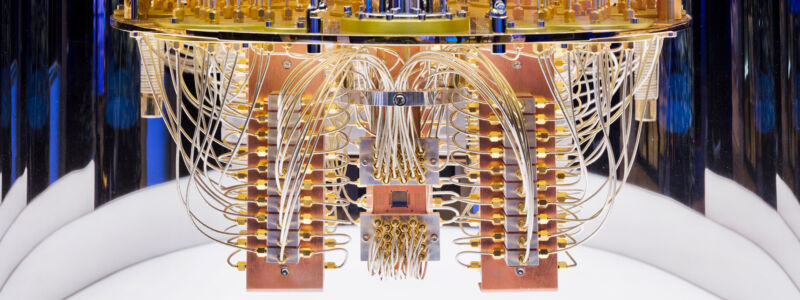
Enlarge / The small quantum processor (center) surrounded by cables that carry microwave signals to it, and the refrigeration hardware.
As we described earlier this year, operating a quantum computer will require a significant investment in classical computing resources, given the amount of measurements and control operations that need to be executed and interpreted. That means that operating a quantum computer will also require a software stack to control and interpret the flow of information from the quantum side.
But software also gets involved well before anything gets executed. While it’s possible to execute algorithms on quantum hardware by defining the full set of commands sent to the hardware, most users are going to want to focus on algorithm development, rather than the details of controlling any single piece of quantum hardware. “If everyone’s got to get down and know what the noise is, [use] performance management tools, they’ve got to know how to compile a quantum circuit through hardware, you’ve got to become an expert in too much to be able to do the algorithm discovery,” said IBM’s Jay Gambetta. So, part of the software stack that companies are developing to control their quantum hardware includes software that converts abstract representations of quantum algorithms into the series of commands needed to execute them.
IBM’s version of this software is called Qiskit (although it was made open source and has since been adopted by other companies). Recently, IBM made a couple of announcements regarding Qiskit, both benchmarking it in comparison to other software stacks and opening it up to third-party modules. We’ll take a look at what software stacks do before getting into the details of what’s new.
What’s the software stack do?
It’s tempting to view IBM’s Qiskit as the equivalent of a compiler. And at the most basic level, that’s a reasonable analogy, in that it takes algorithms defined by humans and converts them to things that can be executed by hardware. But there are significant differences in the details. A compiler for a classical computer produces code that the computer’s processor converts to internal instructions that are used to configure the processor hardware and execute operations.
Even when using what’s termed “machine language,” programmers don’t directly control the hardware; programmers have no control over where on the hardware things are executed (ie, which processor or execution unit within that processor), or even the order instructions are executed in.
Things are very different for quantum computers, at least at present. For starters, everything that happens on the processor is controlled by external hardware, which typically act by generating a series of laser or microwave pulses. So, software like IBM’s Qiskit or Microsoft’s Q# act by converting the code they’re given into commands that are sent to hardware that’s external to the processor.
These “compilers” must also keep track of exactly which part of the processor things are happening on. Quantum computers act by performing specific operations (called gates) on individual or pairs of qubits; to do that, you have to know exactly which qubit you’re addressing. And, for things like superconducting qubits, where there can be device-to-device variations, which hardware qubits you end up using can have a significant effect on the outcome of the calculations.
As a result, most things like Qiskit provide the option of directly addressing the hardware. If a programmer chooses not to, however, the software can transform generic instructions into a precise series of actions that will execute whatever algorithm has been encoded. That involves the software stack making choices about which physical qubits to use, what gates and measurements to execute, and what order to execute them in.
The role of the software stack, however, is likely to expand considerably over the next few years. A number of companies are experimenting with hardware qubit designs that can flag when one type of common error occurs, and there has been progress with developing logical qubits that enable error correction. Ultimately, any company providing access to quantum computers will want to modify its software stack so that these features are enabled without requiring effort on the part of the people designing the algorithms.